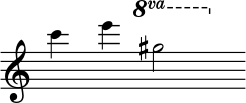Spanners
A common pattern in notation is objects which span between one and another, for example hairpins, slurs, and octave lines. Neoscore supports this through a family of Spanner classes. Most spanners are created in the same way by providing an initial position and parent, and an end position and parent.
staff = Staff(ORIGIN, None, Mm(40))
Clef(ZERO, staff, 'treble')
start = Chordrest(Mm(2), staff, ["f"], (1, 4))
Chordrest(Mm(12), staff, ["a"], (1, 4))
end = Chordrest(Mm(22), staff, ["c#'"], (1, 2))
Hairpin((ZERO, staff.unit(6)), start, (ZERO, staff.unit(6)), end)

The ending parent can usually be omitted to make the ending position relative to the initial position.
staff = Staff(ORIGIN, None, Mm(40))
Clef(ZERO, staff, 'treble')
start = Chordrest(Mm(2), staff, ["f"], (1, 4))
Hairpin((ZERO, staff.unit(6)), start, (staff.unit(3), ZERO))

Hairpins
Crescendo and diminuendo Hairpins, demonstrated above, can be configured in several ways. By default the opening points right, but this can be changed with the direction argument. They can also lie at angles and the default opening width can be configured.
staff = Staff(ORIGIN, None, Mm(40))
Clef(ZERO, staff, 'treble')
start = Chordrest(Mm(2), staff, ["f"], (1, 4))
Hairpin((ZERO, staff.unit(6)), start, (staff.unit(3), staff.unit(-4)),
direction=DirectionX.LEFT, width=staff.unit(1))

Slurs and Ties
Slur are created with the Slur class. By default they arch upward, but this can be changed with the direction argument.
staff = Staff(ORIGIN, None, Mm(40))
Clef(ZERO, staff, 'treble')
start = Chordrest(Mm(2), staff, ["f"], (1, 4))
Chordrest(Mm(12), staff, ["a"], (1, 4))
end = Chordrest(Mm(22), staff, ["c#'"], (1, 2))
Slur((ZERO, staff.unit(-1)), start.stem.end_point, end.extra_attachment_point, end)

Ties work identically to slurs, except they are automatically constrained to be horizontal.
staff = Staff(ORIGIN, None, Mm(40))
Clef(ZERO, staff, 'treble')
start = Chordrest(Mm(2), staff, ["f"], (1, 4))
end = Chordrest(Mm(22), staff, ["f"], (1, 4))
Tie(start.extra_attachment_point, start,
end.extra_attachment_point.x, end, direction=DirectionY.DOWN)

For both classes, a reasonable curvature is automatically derived from the spanner length, but this can be overridden with the height and arch_length arguments.
Tuplets
Since neoscore’s Chordrest model only accounts for written durations, Tuplets are specified visually as separate objects spanning the Chordrest group.
staff = Staff(ORIGIN, None, Mm(40))
Clef(ZERO, staff, 'treble')
group = [
Chordrest(ZERO, staff, ["c"], (1, 8)),
Chordrest(Mm(8), staff, ["d"], (1, 8)),
Chordrest(Mm(16), staff, ["eb"], (1, 8))
]
BeamGroup(group)
Tuplet((ZERO, Mm(-6)), group[0], (ZERO, Mm(-6)), group[-1], "3", include_bracket=False)

staff = Staff(ORIGIN, None, Mm(40))
Clef(ZERO, staff, 'treble')
start = Chordrest(Mm(5), staff, ["c"], (1, 8))
Chordrest(Mm(10), staff, None, (1, 8))
Chordrest(Mm(15), staff, ["d"], (1, 8))
Chordrest(Mm(20), staff, ["e"], (1, 8))
end = Chordrest(Mm(25), staff, None, (1, 8))
Tuplet((ZERO, Mm(-2)), start, (Mm(5), Mm(-2)), end, "5:4", bracket_dir=DirectionY.UP)

Octave Lines
Cosmetic OctaveLines can be drawn with a variety of common octave indications, but note that they do not automatically transpose the notes under them.
staff = Staff(ORIGIN, None, Mm(40))
Clef(ZERO, staff, 'treble')
Chordrest(Mm(2), staff, ["c''"], (1, 4))
Chordrest(Mm(12), staff, ["e''"], (1, 4))
# Note that this transposition is manual
Chordrest(Mm(22), staff, ["g#'"], (1, 2))
OctaveLine((Mm(18), staff.unit(-4)), staff, Mm(15))

Repeating Music Text Lines
RepeatingMusicTextLine allows you to repeat some music text over a spanner. This is useful for things like trill lines.
staff = Staff(ORIGIN, None, Mm(40))
Clef(ZERO, staff, 'treble')
c = Chordrest(Mm(2), staff, ["c'"], (1, 1))
RepeatingMusicTextLine((ZERO, staff.unit(-1)), c, (Mm(20), ZERO), None, "wiggleTrill")

You can optionally provide a glyph to use as a start cap.
staff = Staff(ORIGIN, None, Mm(40))
RepeatingMusicTextLine((ZERO, staff.unit(-1)), staff, (staff.unit(10), ZERO), None,
"wiggleTrill", "ornamentTrill")

Similarly you can provide a glyph to use as an end cap.
staff = Staff(ORIGIN, None, Mm(40))
Clef(ZERO, staff, 'treble')
start = Chordrest(Mm(2), staff, ["c'"], (1, 1))
end = Chordrest(Mm(25), staff, ["c''"], (1, 4))
RepeatingMusicTextLine((staff.unit(2), ZERO), start.highest_notehead,
(staff.unit(0), ZERO), end.highest_notehead,
"wiggleGlissando", None, "wiggleArpeggiatoUpArrow")

See SMuFL’s collection of multi-segment line glyphs here for common applications.
Arpeggio Lines
Arpeggio lines can be built with RepeatingMusicTextLine, but for convenience we provide one out of the box with ArpeggioLine.
staff = Staff(ORIGIN, None, Mm(40))
Clef(ZERO, staff, 'treble')
c = Chordrest(staff.unit(3), staff, ["c", "g", "eb"], (1, 16))
ArpeggioLine((staff.unit(-2), staff.unit(-1)), c.highest_notehead,
(staff.unit(-2), staff.unit(2)), c.lowest_notehead, include_arrow=True)

For chordrests specifically, the dedicated ArpeggioLine.for_chord can automatically work out the line positions for you.
staff = Staff(ORIGIN, None, Mm(40))
Clef(ZERO, staff, 'treble')
c = Chordrest(staff.unit(3), staff, ["c", "g", "eb'"], (1, 16))
ArpeggioLine.for_chord(c, DirectionY.UP)

Other Spanners
Other available spanners include: